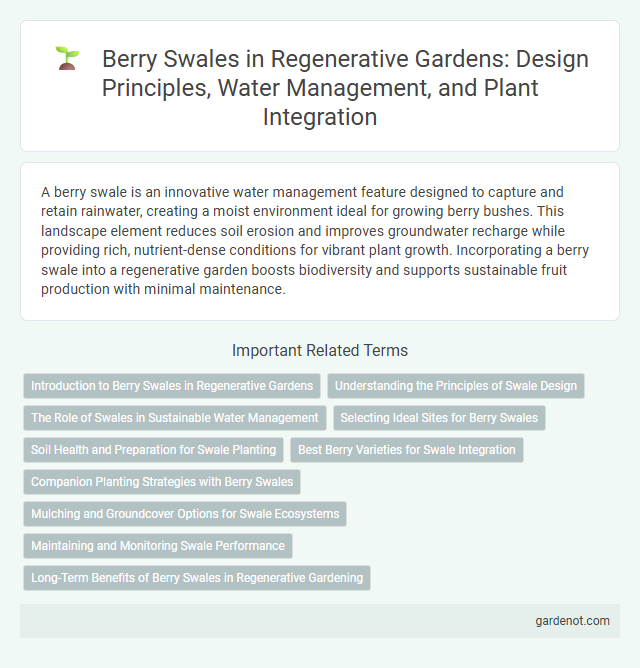A berry swale is an innovative water management feature designed to capture and retain rainwater, creating a moist environment ideal for growing berry bushes. This landscape element reduces soil erosion and improves groundwater recharge while providing rich, nutrient-dense conditions for vibrant plant growth. Incorporating a berry swale into a regenerative garden boosts biodiversity and supports sustainable fruit production with minimal maintenance.
Introduction to Berry Swales in Regenerative Gardens
Berry swales are designed earth contours that enhance water retention and support plant growth by channeling rainwater directly to berry plants in regenerative gardens. These swales improve soil health and boost berry yield by reducing erosion and increasing moisture availability. Integrating berry swales into regenerative landscapes promotes biodiversity and sustainable food production.
Understanding the Principles of Swale Design
Berry swales are designed by contouring the land to capture and slowly infiltrate rainwater, enhancing soil moisture for berry plants and reducing erosion. Key principles include aligning swales along natural contour lines to maximize water retention and ensure even distribution, while incorporating gentle slopes to facilitate controlled water flow without runoff. Proper soil composition and mulch layers within berry swales improve water absorption and promote healthy root growth, supporting sustainable berry production in regenerative gardens.
The Role of Swales in Sustainable Water Management
Berry swales play a crucial role in sustainable water management by capturing and infiltrating rainwater, reducing runoff and erosion in regenerative gardens. These earthworks create microclimates that support berry plants' growth while replenishing groundwater and improving soil health. By integrating swales, gardens enhance water efficiency and promote resilient ecosystems.
Selecting Ideal Sites for Berry Swales
Berry swales thrive in well-drained, gently sloping areas with consistent sunlight exposure to maximize berry growth and water retention. Optimal locations avoid heavy clay soils prone to waterlogging, instead favoring loamy or sandy textures that facilitate root aeration and prevent erosion. Positioning berry swales near natural water flow paths enhances rainwater capture, supporting sustainable irrigation and healthy plant development.
Soil Health and Preparation for Swale Planting
Berry swales enhance soil health by promoting water retention and preventing erosion through strategic contouring and organic mulch application. Soil preparation involves deep loosening, incorporation of rich compost, and pH balancing to create a nutrient-dense environment for berry plants. This regenerative approach ensures strong root development and sustainable moisture levels, optimizing berry growth and yield.
Best Berry Varieties for Swale Integration
Best berry varieties for swale integration include thornless blackberries (Rubus fruticosus), hardy blueberries (Vaccinium corymbosum), and elderberries (Sambucus canadensis), all known for their deep root systems that enhance soil stability and water retention. These berries thrive in moist, well-drained swale environments and contribute to nutrient cycling through their leaf litter and fruit production. Incorporating these varieties supports biodiversity and maximizes the regenerative potential of garden swales by creating resilient, productive plantings.
Companion Planting Strategies with Berry Swales
Berry swales integrate companion planting strategies by pairing nutrient-fixing plants like clover and lupines with berry bushes to enhance soil fertility and moisture retention. Deep-rooted companions such as comfrey improve water infiltration and provide mulch, supporting the swale's water management. This synergy boosts berry yield and resilience by creating a balanced micro-ecosystem within the regenerative garden.
Mulching and Groundcover Options for Swale Ecosystems
Mulching in berry swales enhances soil moisture retention, reduces erosion, and suppresses weeds, creating ideal conditions for plant growth. Groundcover options such as clover, creeping thyme, and native grasses stabilize the soil and provide nutrient cycling within swale ecosystems. Incorporating organic mulches like straw or wood chips enriches soil texture and supports beneficial microbial activity in these regenerative garden zones.
Maintaining and Monitoring Swale Performance
Regular inspection of berry swales ensures efficient water infiltration and prevents erosion by checking soil saturation levels and vegetation health. Monitoring involves measuring runoff volume and velocity during rainfall events to assess swale capacity and identify potential blockages. Maintaining organic mulch and repairing any breaches in berms promote optimal swale performance and enhance groundwater recharge.
Long-Term Benefits of Berry Swales in Regenerative Gardening
Berry swales enhance soil moisture retention and prevent erosion, promoting healthier plant growth and biodiversity in regenerative gardens. They support beneficial microorganisms and provide habitat for pollinators, boosting ecosystem resilience over time. Sustainable water management through berry swales contributes to improved yield and carbon sequestration.
Berry swale Infographic

 gardenot.com
gardenot.com